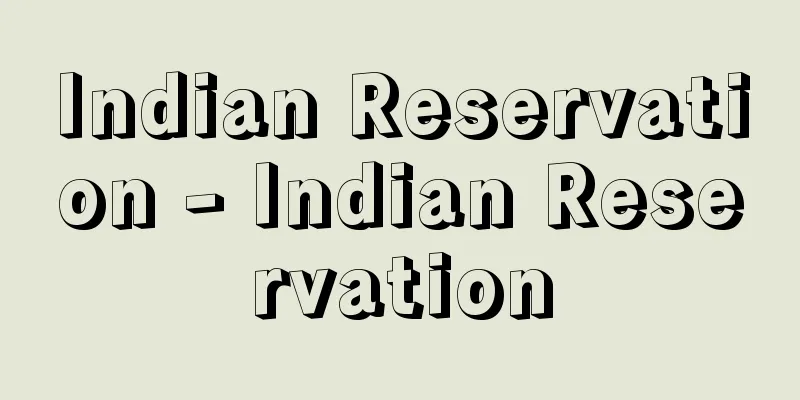Indian Reservation - Indian Reservation

|
Officially designated indigenous settlements in the United States and Canada. During the war of conquest by whites, indigenous peoples' settlements were often seized by force, purchase, or forced relocation, and limited portions of them were given to them. In the United States, reservations are called Indian reservations, and are under the jurisdiction of the Bureau of Indian Affairs of the Department of the Interior. In 1881, the area was about 630,000 km2 , but it gradually narrowed due to policies based on the Dawes Act and other factors. Although the number of reservations was limited in the 1930s, there are currently about 500 reservations, including Alaska, covering a total of 220,000 km2 (22.5% of the country's Indian population resides there). Of these, 278 are on the mainland of the United States, mostly in the southwest and central north. In Canada, reservations are called Indian reserves, and are under the jurisdiction of the Department of Indian Affairs and Northern Development. There are 2,284 reservations nationwide, covering a total of 26,000 km2 . In both countries, residents receive services such as education, welfare, and pensions funded by the national budget, and the basic policy is for residents to self-govern under government protection. However, many of the reservations are not suitable for agriculture and are in remote areas with no industry. Traditional occupations such as gathering and hunting are virtually impossible to carry out, and the unemployment rate is high. Living facilities and sanitary conditions are poor, and the average life expectancy of residents is short. Other issues include environmental pollution and exposure of residents to radiation from nuclear testing (in Nevada, USA, and elsewhere). On the other hand, since the restoration movement of the 1960s, there have been movements calling for the restoration of indigenous cultures and religions, as well as land rights including those for underground resources, and hunting rights. →Reservation / American Indian / Pan-Indian Movement Source : Heibonsha Encyclopedia About MyPedia Information |
|
アメリカ合衆国およびカナダにおいて公的に指定された先住民族の居住地。白人による征服戦争の過程で,先住民の居住地を多くは武力,あるいは購入,強制移住などによって奪取し,その一部を限定して与えたものである。合衆国における保留地はIndian reservationと呼ばれ,内務省インディアン局が管轄。1881年には約63万km2であったが,ドーズ法に基づく政策などによってしだいに狭められた。1930年代に歯止めがかかったものの,現在はアラスカを含めて約500ヵ所,計22万km2となっている(同国インディアン人口の22.5%が居住)。うち合衆国本土には278ヵ所があり,南西部,中央北部に多い。カナダの保留地はIndian reserveと呼ばれ,インディアン問題・北方開発省が管轄。全国に2284ヵ所,計2万6000km2。両国ともに国家予算による教育,福祉,年金などのサービスを受け,政府の保護に基づく住民自治がその基本政策となっている。しかし,保留地の多くは農業に適さないうえ産業もない僻地が多く,また採集・狩猟などの伝統的な生業を行うことも事実上不可能で,失業率が高い。居住施設や衛生状態も貧弱で,住民の平均寿命は短い。環境汚染,核実験による住民の被曝(米国ネバダ州ほか)なども問題となっている。一方で,1960年代の復権運動以来,固有の文化や宗教の回復や,地下資源を含む土地権,狩猟権などを求める運動も展開されている。→リザーベーション/アメリカ・インディアン/パン・インディアン運動
出典 株式会社平凡社百科事典マイペディアについて 情報 |
<<: Indian Runner [species] - Indian Runner
Recommend
Shell Chest - Kaihitsu
...For this game, clam shells are divided into ri...
Sun image - Nichizo
Year of death: Kōei 1/Kōkoku 3.11.13 (1342.12.11) ...
S-polarized light
...The relationship between the amplitude and pha...
Czepko, D.von (English spelling) CzepkoDvon
…He studied medicine in various places and became...
Yellow Gentian - Yellow Gentian
…There are about 2,000 species in the world, and ...
Oistrakh, ID (English) OistrakhID
…A Soviet violinist and one of the most famous pe...
jester
…The word fool originates from the Latin follis (...
Cone pepper
…var. cerasiforme (cherry pepper) is a variety cu...
GPS - Shiihiesu, GPS
Abbreviation of Global Positioning System. In Japa...
Josip Jelačić
1801‐59 Governor of Croatia in northern Yugoslavia...
Isawa [town] - Isawa
This is an old town in Isawa County, located in th...
Ionization chamber - denribako
A device that measures the intensity, dose, and e...
Icelandic - Icelandic
The national language of the Republic of Iceland....
Jakkoji Temple
This temple is of the Kenhon Hokke sect and is loc...
Office machines - Jimukikai
Generally speaking, this refers to equipment used ...





![Kayo [town] - Kayo](/upload/images/67cb40f33bb01.webp)



